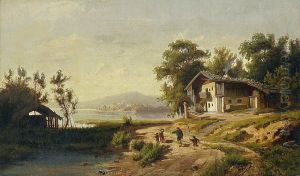J. M. Meeker Paintings
Joseph Meeker, often referred to as J. M. Meeker, was an American artist known for his landscape paintings. Born on February 21, 1827, in Newark, Ohio, Meeker showed an early proclivity for the arts. His career, however, did not begin in painting, but rather in more practical endeavors. He initially worked in engineering and architecture before pursuing his passion for painting.
Meeker studied under the tutelage of Henry W. Ranger, a prominent figure in the development of American landscape painting. He also attended the National Academy of Design in New York, which played a crucial role in shaping his artistic skills and vision. In 1859, Meeker ventured to Europe, where he was deeply influenced by the Barbizon School, a group of French painters who embraced naturalism and often depicted pastoral landscapes.
Upon returning to the United States, Meeker settled in St. Louis, Missouri. His experiences in the American South and the Midwest informed his artistic focus, as he became particularly renowned for his paintings of the Louisiana bayou and the vast, unspoiled scenery of the Mississippi River. Meeker's works often reflected a serene and harmonious relationship between humans and nature, characterized by detailed vegetation, calm waters, and soft, atmospheric effects.
During his lifetime, Meeker's art was well-received, and he exhibited at various institutions, including the Pennsylvania Academy of the Fine Arts and the Boston Art Club. Despite this, he struggled financially and did not gain the same level of fame as some of his contemporaries. J. M. Meeker passed away on October 31, 1889, in Bronx, New York. Today, his paintings are recognized for their contribution to American landscape art and are included in the collections of several museums and galleries across the country.
